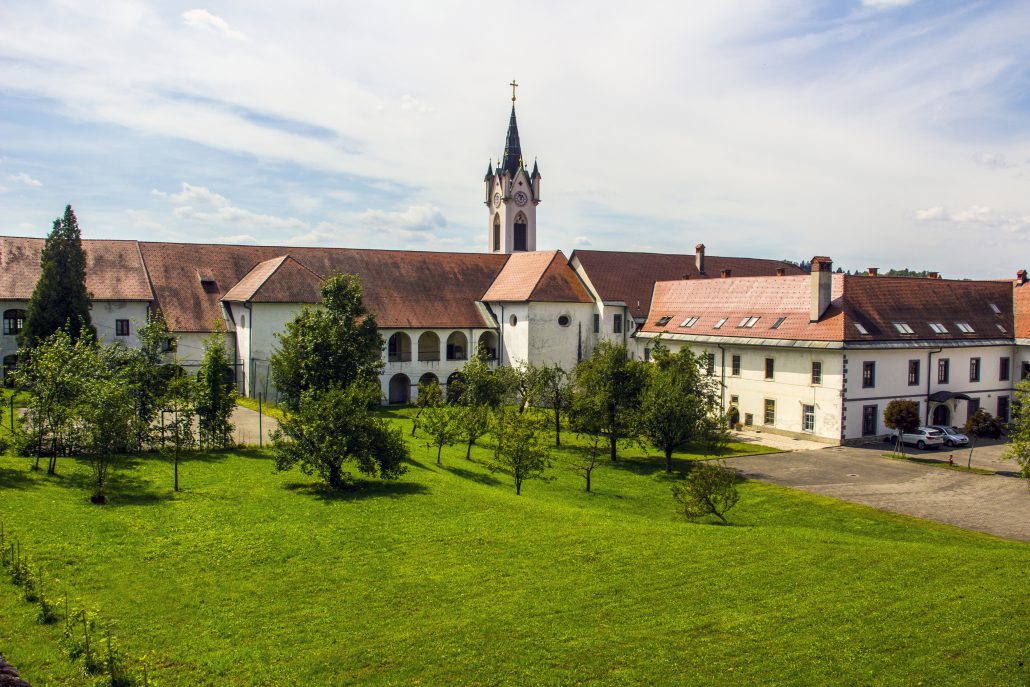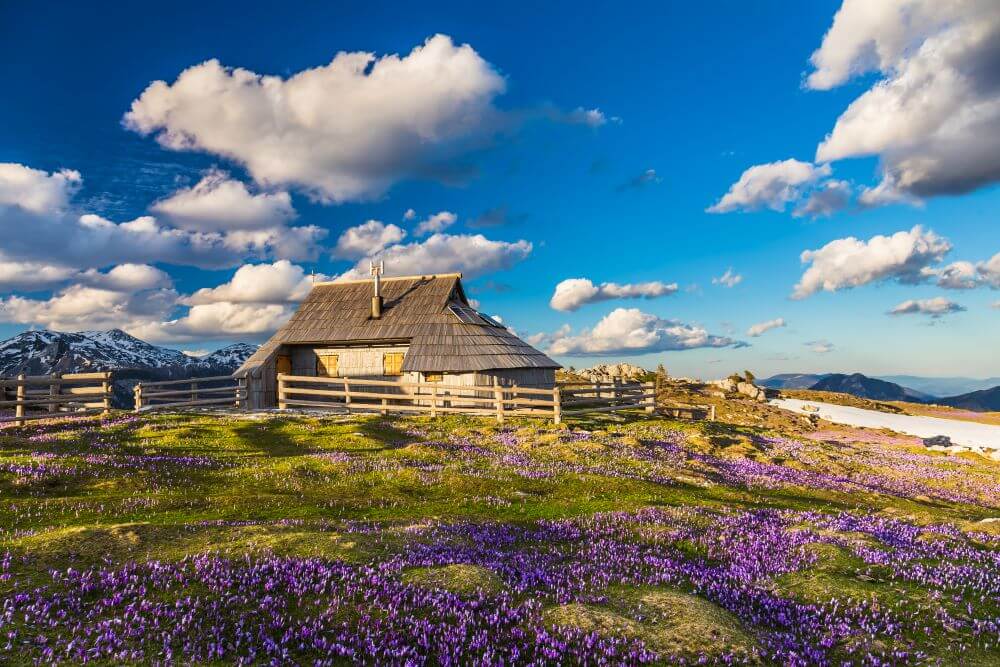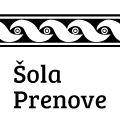Along the paths of Plečnik
Discover Plečnik's architecture, symbols and special features of inspired candle making.
From the Town fountain to the monastery
Start your wander around the town on Glavni trg main square (1), where you will be greeted by the town fountain. Take a look at the famous façade, then head towards the Church of St. James and the Franciscan Monastery with the Chapel of the Holy Sepulcher (2). This chapel with an abundance of symbolism is considered one of Plečnik’s most famous works.
Recommended time for viewing: 15 minutes. You need 1 minute to the next stop.
From Plečnik’s station to granaries
We head from Samostanska ulica Street past the Evropa park to the Kamnik mesto railway station (3), designed by Plečnik and his students. Then, continue along Kolodvorska ulica Street to Zaprice (4), where you can see an open-air museum with granaries from the Tuhinj Valley and a lapidarium. There is a beautiful view of the town from the castle garden.
Recommended time for viewing: 20 minutes. You need 15 minutes to the next stop.
Along the most beautiful street
When you descend from the castle back to the town, go for a walk along Šutna (5) – the most beautiful Kamnik street, inspired by urban crafts. As you reach Rudolf Maister’s birth house (6), take a look at the memorial plaque on the façade designed by Jože Plečnik. Just a few meters away is the church of St. Mary Immaculate (7), where you can admire the works of art of Jelovšek, Metzinger, Stele and also Plečnik.
A Tip: Complement your wanderings with a culinary experience. Stop at the Korobač inn in Šutna, which you see as you descend from the castle. The inn is a meeting point of history, culture and society with an emphasis on local specialities. Here you can try local beers and sweeten up with tasty vegan desserts.
Recommended time for viewing: 45 minutes. You need 15 minutes to the next stop.
Get a candle with Plečnik's motive
At the end of Šutna, continue your way through the Samec pass back to Glavni trg main square. Enter Lectar’s house (8), where the architecture is also adapted to beeswax bleaching under the influence of sunlight. Here you can make candles based on a Plečnik’s motif by prior arrangement, or choose the desired candle product from the store’s offer.
Recommended time for viewing: 15 – 90 minutes.
Suggestion for a hike
To an exhibition in Mekinje
From Kamnik, you can take the approximately 3-kilometre route to Mekinje. An exhibition on Plečnik’s works, which was hosted in Japan years ago, is on display at the Mekinje Monastery.
Continue from Glavni trg over the Maister bridge, through the park and then again across the bridge, designed by Jože Plečnik. Follow Prašnikar tree-lined road and Cankarjeva cesta Road untill you reach the monastery, where first the Poor Clares and later the Ursuline Sisters worked, who in 2016 donated the monastery to the Municipality of Kamnik.
More information: Javni zavod Mekinjski samostan -The Mekinje Monastery Public Institution
www.samostanmekinje.si

1. Main square
In 1953, Plečnik made plans to regulate the main square in Kamnik and to transform façades. The main façade of the building, overlooking Maister Street, is distinguished by the use of the grouting stone technique. In front of the building, Plečnik planned a pillar shed, and a wall fountain beneath it. The architect Anton Bitenc completed the project. He designed a fountain with two round troughs and a pillar with recognizable elements of Kamnik. The animal skin symbolizes the leather craft, the gear the metal industry, the anvil is reminiscent of blacksmithing, and there is also the famous Kamnik majolica.
2. The church of St. James and the Franciscan monastery
The Franciscan monastery, built at the end of the 15th century next to the former Gothic Church of St. James, houses the Chapel of the Holy Sepulcher – one of Plečnik’s last creations. The chapel in the hallway of the church presbytery was completed in 1954. The metal lights on the ceiling create the look of a starry sky. The beams on the ceiling of the altar indicate the barn or the Christ’s manger, whereas the monolithic tabernacle symbolizes Christ’s rock tomb.
Franciscan square 2
3. The Kamnik mesto railway station
Plečnik usually arrived in Kamnik by train, where the locals waited for him with a horse team. He also left his mark at the Kamnik mesto Railway Station. The latter was completed in 1941 and planned by Plečnik’s student Vinko Glanz. Plečnik is supposed to have determined the shape of the roof and façade of stone and brick at the end.
Kolodvorska 3
4. Zaprice manor
On a small hill above the town, a small defence tower was built as early as the 14th century. Since 1550, it has been the site of the Zaprice Manor – a residential rural mansion. The manor houses the Intermunicipal Museum Kamnik with a permanent exhibition on the history of the area. Since 1968, there has also been an open-air museum, representing rustic outbuildings (granaries, a drying chamber for fruit, a fruit crushing device, and a well) from the 18th and 19th centuries. The oldest granary dates from 1793. The interior has also been preserved.
Medobčinski muzej Kamnik – Intermunicipal Museum Kamnik, Muzejska pot 3 01 8317 662
5. Šutna
A medieval settlement south of Mali grad was first mentioned as a suburb in the 13th century. Then, it was located on the edge of the town walls, but today it is the most beautiful part of the centre. It is adorned with characteristic signboards and other craft signs. The Samec pass marks the end of Šutna. Until 1882, there was a slope there, which the then mayor had lowered. The wall of the pass is a backdrop for occasional events.
6. The Rudolf Maister birthplace
Rudolf Maister (1874 – 1934) was a Slovene general, patriot, poet and bibliophile. Get to know the life story of the general, who played a decisive role in shaping the new borders of the State of Slovenes, Croatians and Serbs at the end of the First World War, by visiting the exhibition in his birth house. On the façade of the house is a memorial plaque made of Podpeč stone, designed by Jože Plečnik. The plaque was revealed in 1938.
Šutna 23, Intermunicipal Museum Kamnik T: 059 097 580
7. The church of St. Mary Immaculate
The parish church in Šutna, built in 1734 on the site of previous churches, has a separate Gothic bell tower from the late Middle Ages. The building of the parish church was ordered by the then priest Maximilian Leopold Rasp. The plans for the construction were drawn by the architect Gregor Maček, and the paintings of the presbytery were made by the best Baroque fresco painter Franc Jelovšek. Plečnik breathed a new image to the church baptistery. Plečnik’s student Erna Tomšič made plans for the renovation according to the architect’s ideas.
Raspov prehod 2
8. The Lectar house
The Lectar family, as the Stele family was also nicknamed, has been making candles and gingerbread for several generations. They operate in one of the oldest houses with a preserved hearth kitchen. There is also a memorial family room, the plans for which were prepared by Jože Plečnik. Wooden furniture is richly decorated with embossed ornaments. The friendship between the architect and the candlemakers also gave birth to the idea of decorating candles with wax castings from moulds for gingerbread. Members of the Stele family still keep plans for decorating candles with colourful patterns and inscriptions. You can buy Plečnik’s candles here.
Pax Candles Stele, Glavni trg 16, T: 01 831 16 84
- 11. Main square
- 22. The church of St. James and the Franciscan monastery
- 33. The Kamnik mesto railway station
- 44. Zaprice manor
- 55. Šutna
- 66. The Rudolf Maister birthplace
- 77. The church of St. Mary Immaculate
- 88. The Lectar house





